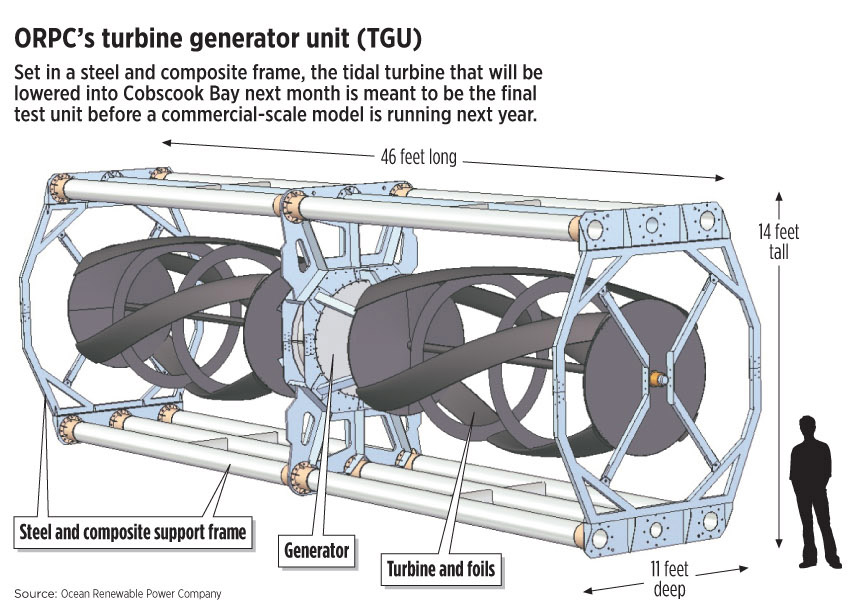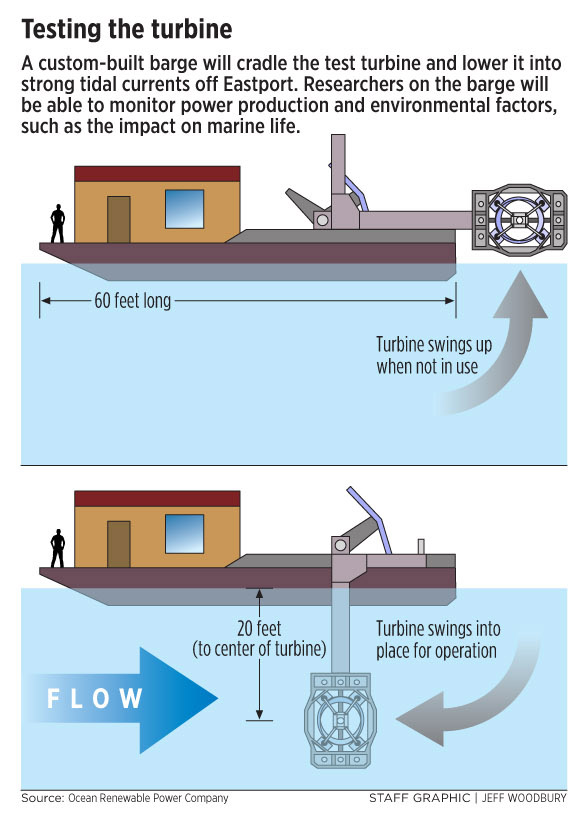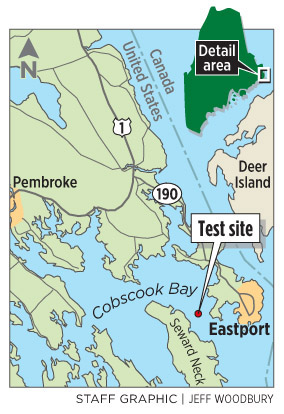EASTPORT – Close by the Canadian border, this stretch of Down East Maine is known worldwide for its high tides and strong ocean currents. Peak tides rush in and out of Cobscook Bay at 7 miles per hour. From a boat, it’s easy to appreciate the force of the water as it piles up against a large, white buoy moored off Shackford Head.
Early next month, if all goes well, that buoy will anchor the country’s largest ocean energy device — an underwater turbine that turns the bay’s surging tides into electricity. Dubbed the Energy Tide 2, the turbine will be a final demonstration before a commercial-scale generating unit is launched, hopefully next year.
For nearly a century, area residents have dreamed of producing power from moving seawater and tapping the economic potential that could flow with it. Now they feel close, closer than at any time since the 1930s, when historic plans to impound and funnel the bay fell apart.
The latest strategy isn’t to dam up Cobscook Bay. Instead, barrel-shaped, Maine-made turbines with composite foils modeled after aircraft wings will be strategically stacked on the ocean floor, minimizing impact to the marine environment.
An earlier prototype of this design was successfully tested three years ago on the city’s other side, in Western Passage, which separates Maine and New Brunswick. Over the next two months, researchers, regulators, investors and ocean energy wonks of all sorts will be coming here. What they find will go a long way toward determining whether Eastport, finally, will become the tidal energy capital of the East Coast.
That significance, and the pressure to make it happen, was clear last week to John Ferland as he stood in the stern of a local fishing boat and gave a tour of the demonstration site. Vice president for project development at Ocean Renewable Power Co., the start-up firm behind the $2.8 million project, Ferland knows how much is riding on this test period, for his company and the community.
”This demonstration is more like a Broadway debut,” he said. ”We need to have a successful experience to maintain the momentum.”
The company is planning a public launch ceremony on March 2 at The Boat School maritime campus here. Company representatives, business partners and government officials are expected at the event, which will include a christening by middle school students.
Based in Portland, six-year- old Ocean Renewable also is working on a tidal project at Cook Inlet, Alaska. It’s also considered a world-class site to harness tidal energy.
Eastport’s mean tides exceed 18 feet, nearly twice the range in Portland. The city is on the American end of a growing, international experiment to extract reliable, cost-effective power from the Gulf of Maine. Across the gulf in the Bay of Fundy, Irish tech company OpenHydro is testing a 1-megawatt turbine in the Minas Passage of Nova Scotia, where tides range 40 feet or more.
A year or so from now, Ocean Renewable could have a 1-megawatt, stackable module of turbines off Eastport. Hooked to the Bangor Hydro-Electric grid, it could generate enough clean power at peak tidal flows to light more than 300 homes, Ferland said, and do it at a price competitive with wind energy.
That could lead to an expanded project with more modules and more output. If the technology can be refined to extract power from slower currents, and Ocean Renewable can win the needed regulatory permits, there may be enough good underwater sites around Eastport to install units with a total capacity of 100 megawatts. Building, installing and maintaining the turbines could create hundreds of jobs in an area where double-digit unemployment is the norm.
Ocean Renewable and its allies were scrambling last week to assemble all the components needed to get Energy Tide 2 in the water.
At the Estes Head cargo pier, workers were outfitting the custom-built, 60-foot barge that will move the turbine to the test site. The barge looks like a floating, one-car garage with big metal arms. Researchers will set up computers and other test equipment inside. The arms will hold the turbine shaft and lower the 13-ton unit into the water column.
Energy Tide 2 has a capacity of 60 kilowatts. Electricity produced during the test period won’t go to the grid. In a related trial, a battery bank set up inside a skiff will be charged to help power the standby heating system of a Coast Guard patrol boat docked at Eastport’s breakwater.
The star of the upcoming show — the turbine — was sitting in two pieces last week on the floor at The Boat School workshop. The sections will be joined around a generator to create a turbine unit 46 feet wide, 14 feet high and 11 feet deep.
Each side features four, helix-shaped foils wrapped around spacing rings and pierced by the turbine shaft. They were manufactured at U.S. Windblade in Bath. The proprietary design is considered the first all-composite fluid-motion turbine built in the United States.
The turbines will rest in a steel and composite frame that was fabricated at Stillwater Metalworks in Bangor. It was being trucked last week to Eastport.
The turbine will turn slowly, roughly 60 revolutions per minute in a 7-mph current. The slow speed and wide foil spacing is meant to let marine life move through unharmed. Researchers will be confirming that with video monitors and sonar.
Overall, the two-month trial will allow Ocean Renewable to check voltage levels and other data, to make sure the power being produced is compatible with the grid. It also will confirm that the company has a design that’s durable enough for production.
”We feel that what we’re putting in the water is our commercial design,” Ferland said. ”Now we can test it for real.”
This test period is crucial to attracting more of the money that has brought Ocean Renewable this far.
The company has operating capital of $13 million. Roughly $3 million has come equally from the U.S. Department of Energy and the Maine Technology Institute. Ocean Renewable also has private investors. It reached a milestone last summer by forming a joint venture with New York City-based Caithness Development LLC, a privately held independent power producer focused on green energy. A successful test could pave the way for Ocean Renewable to sell its technology to other tidal developers.
The potential is very exciting to leaders in Eastport, where recent job losses and lingering effects of the recession have intensified the city’s economic isolation.
Longtime residents know the history of the Passamaquoddy Tidal Power Project, the grand vision of then-President Franklin Roosevelt to dam area bays and generate electricity. They’re reminded, each time they drive along the abandoned dam-turned-causeway that now connects the city to the mainland, of the lost promise of tidal energy.
”Roosevelt’s dream took deep root in the public consciousness,” said Senate Minority Leader Kevin Raye, who owns a downtown business and lives in neighboring Perry.
But now Eastport has another chance, he said, with innovative technology that has a low impact on the environment. Ocean Renewable has reached out to fishermen and local officials to win almost universal support in the community, he said. The company’s aspirations have given the area a renewed sense of optimism.
”It’s really the fulfillment of a dream that goes back generations,” Raye said.
Staff Writer Tux Turkel can be contacted at 791-6462 or
tturkel@pressherald.com
Send questions/comments to the editors.







Success. Please wait for the page to reload. If the page does not reload within 5 seconds, please refresh the page.
Enter your email and password to access comments.
Hi, to comment on stories you must . This profile is in addition to your subscription and website login.
Already have a commenting profile? .
Invalid username/password.
Please check your email to confirm and complete your registration.
Only subscribers are eligible to post comments. Please subscribe or login first for digital access. Here’s why.
Use the form below to reset your password. When you've submitted your account email, we will send an email with a reset code.